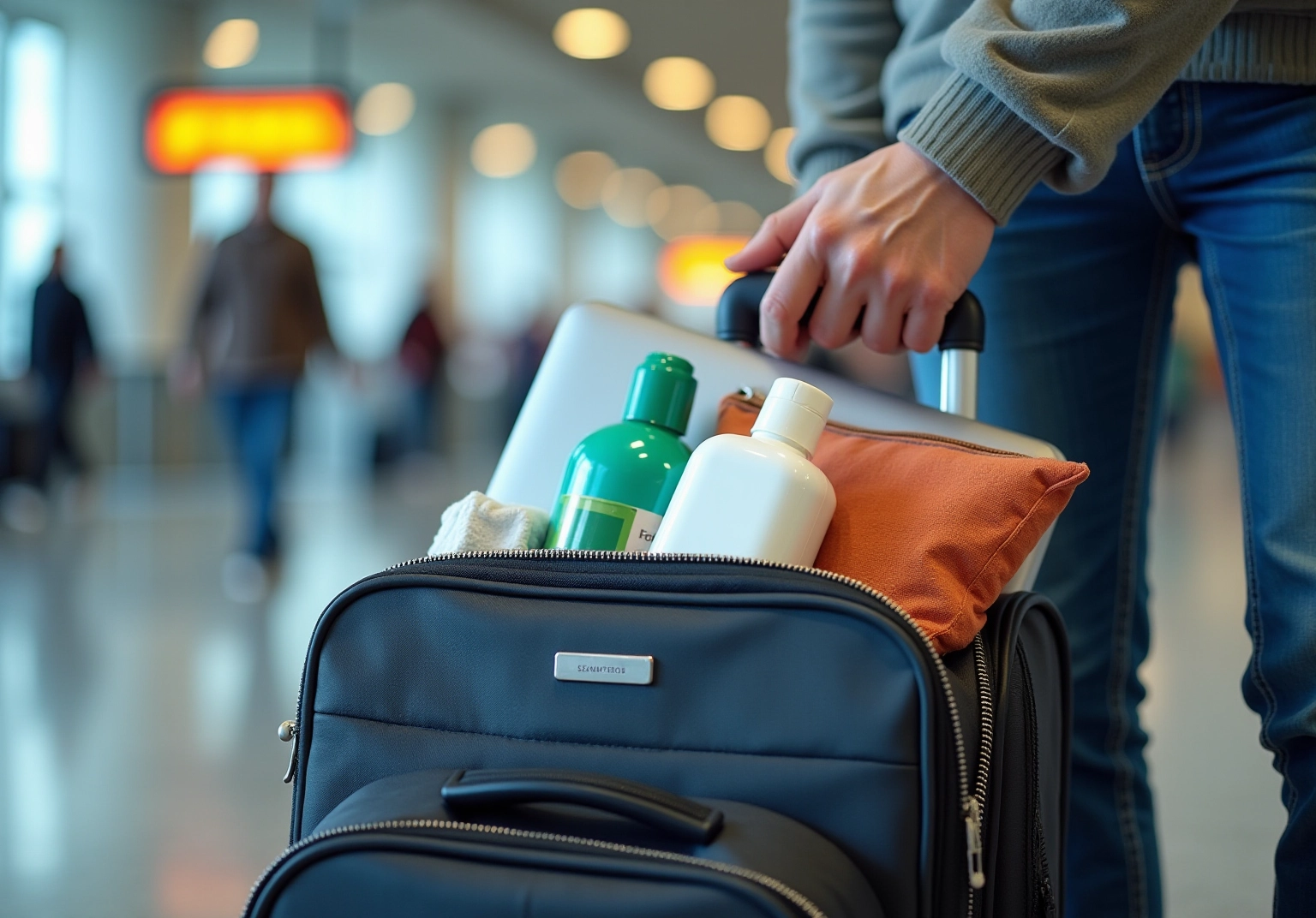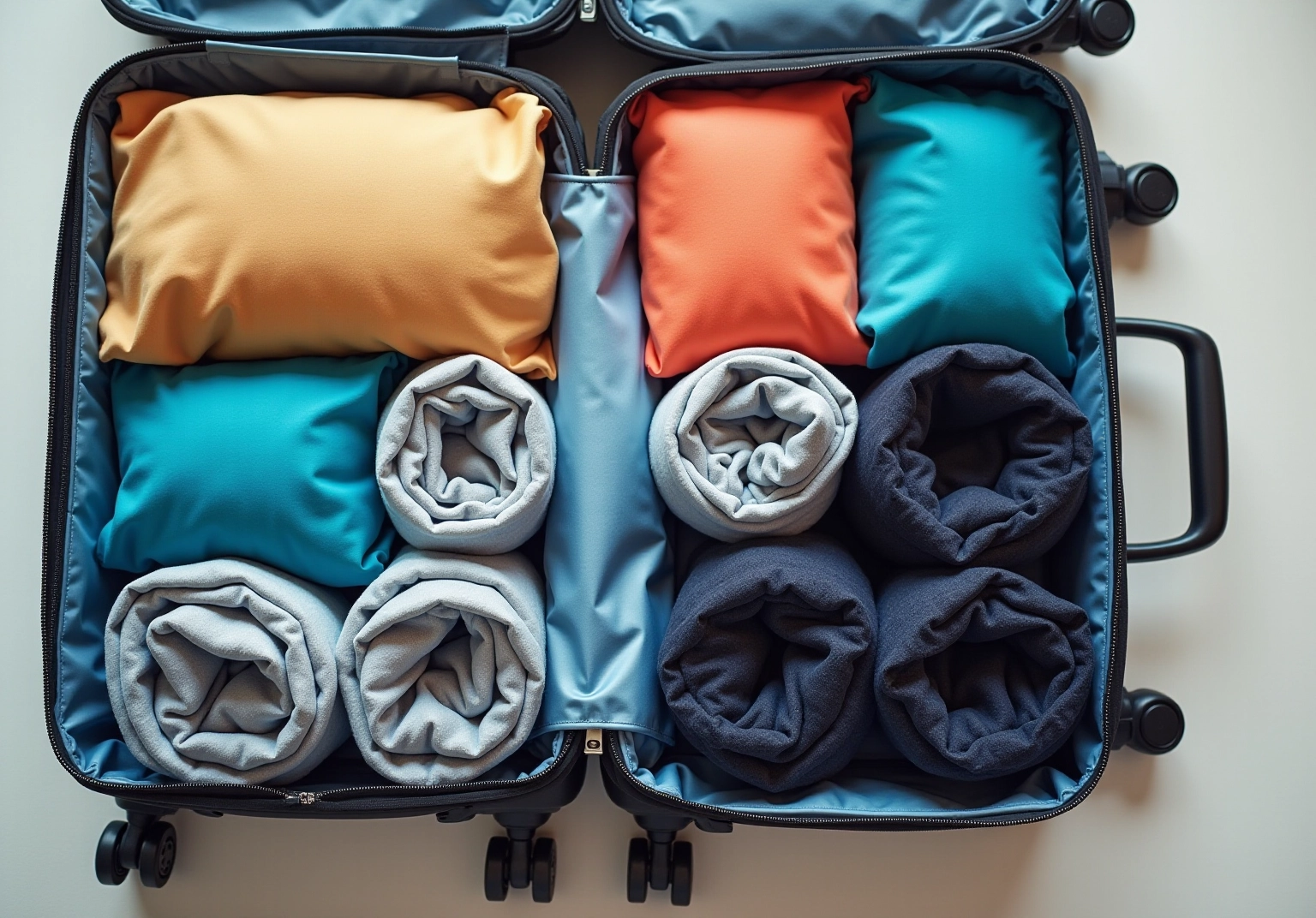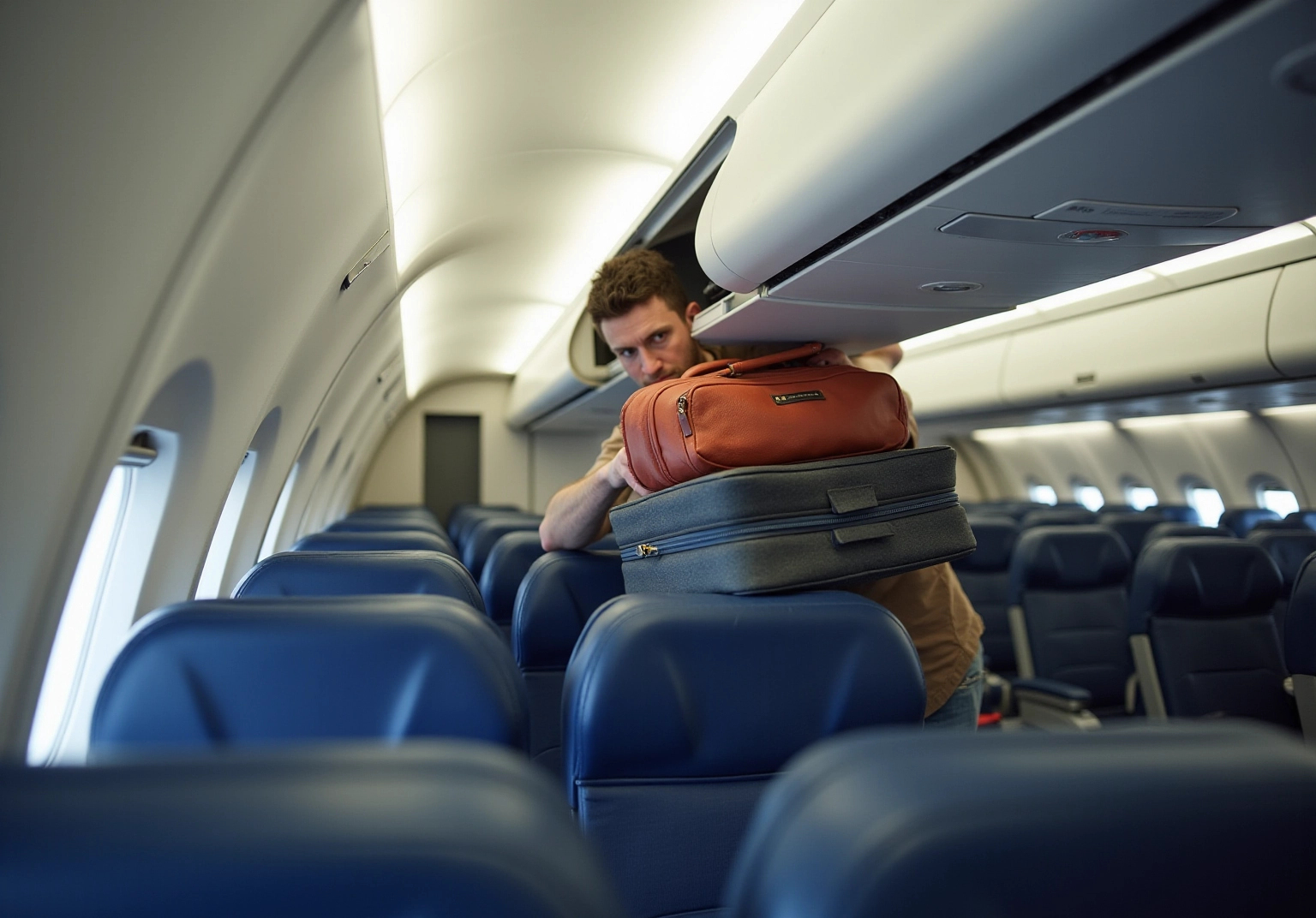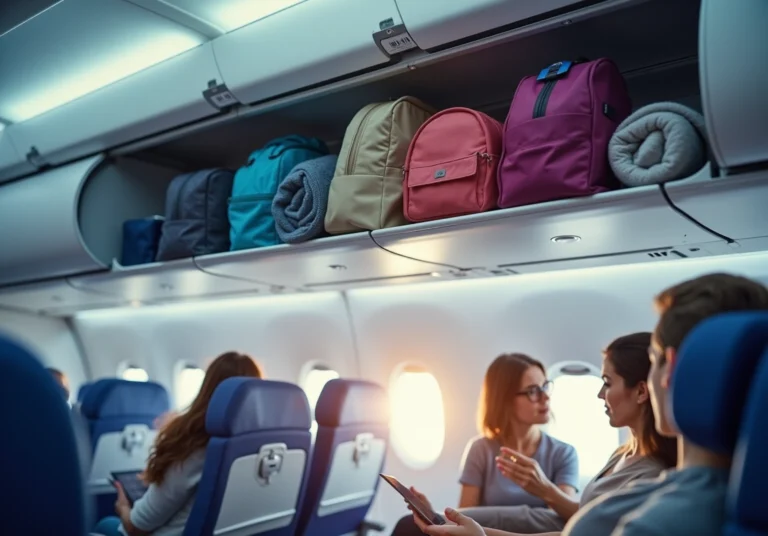Overview
This article is all about mastering the use of airplane overhead bins for efficient packing! You’ll find helpful guidelines on size restrictions, packing techniques, and etiquette that can make your travels smoother. Understanding airline regulations is key, and I can’t stress enough how useful space-saving methods like rolling your clothes and using packing cubes can be! Plus, being considerate of your fellow travelers when sharing that precious overhead bin space is a game changer. Let’s dive in and discover how these tips can transform your travel experience!
Key Highlights:
- Most airlines have hand luggage size restrictions, typically around 22 x 14 x 9 inches.
- Weight limits vary by airline; domestic carriers may not enforce strict limits, while international airlines often do.
- TSA regulations prohibit sharp objects and liquids over 3.4 ounces; the 3-1-1 rule allows a quart-sized bag of liquids.
- Packing techniques like rolling clothes save space and reduce wrinkles, allowing for more outfits in a carry-on.
- Using packing cubes can help organise belongings and separate clean and dirty clothes.
- Important items should be kept in an outer pocket for easy access during travel.
- Overhead bin etiquette includes positioning bags with wheels facing forward and being considerate of shared space.
- Boarding early can help secure space for larger carry-on bags, while smaller bags can be stored under the seat.
Introduction
Navigating the complexities of airplane travel can feel a bit overwhelming, can’t it? Especially when it comes to managing carry-on luggage and maximizing that precious overhead bin space! With airlines enforcing specific size and weight restrictions, it’s crucial to understand these regulations for a hassle-free journey.
This guide is here to share some valuable techniques for efficient packing, helping you fit all your essentials into the limited space available. But what happens when the overhead bin is full, and your carefully packed bag has nowhere to go?
Let’s discover together how to master the art of overhead bin use and transform your travel experience into one of ease and efficiency!
Understand Carry-On Baggage Regulations
Before you pack your bags, let’s dive into the baggage rules of your airline! Most airlines have specific size restrictions for hand luggage that must fit in the airplane overhead bin, usually around 22 x 14 x 9 inches. While many domestic U.S. carriers don’t enforce a strict weight limit, some, like Hawaiian Airlines, set a maximum of 25 pounds, and Frontier Airlines allows up to 35 pounds. If you’re flying internationally, be prepared for stricter weight limits; for example, Singapore Airlines only permits 15 pounds. Always check your airline’s website for the most accurate dimensions and weight restrictions to avoid any surprises at the airport!
And don’t forget about those pesky prohibited items! Sharp objects and liquids over 3.4 ounces are a no-go due to TSA regulations. Thanks to the TSA’s 3-1-1 rule, you can bring a quart-sized bag of liquids, aerosols, gels, creams, and pastes through security. Getting familiar with these regulations not only helps you dodge last-minute packing dilemmas but also ensures a smoother travel experience.
For instance, did you know that Southwest Airlines allows a personal item size of 24 x 16 x 10 inches to fit in the airplane overhead bin without a specified weight limit? Meanwhile, Spirit Airlines has a size limit of 22 x 18 x 10 inches, and they do charge fees for larger bags. Knowing these policies can really enhance your travel efficiency and comfort! As Fred Perrotta, co-founder and CEO of Tortuga, puts it, “We believe in traveling light, which means carry-on-only.” This philosophy really highlights the importance of understanding carry-on regulations and optimizing your packing strategy.

Pack Smart: Techniques for Efficient Packing
To pack efficiently, start by choosing versatile clothing items that you can easily mix and match. Have you ever tried rolling your clothes instead of folding them? Not only does it save space, but it also minimizes wrinkles—many travelers swear by this method! For example, when you roll your clothes, you can fit more outfits into a TSA-approved carry-on suitcase. It’s fascinating to note that rolling takes up about 1,445.1 cm³ per outfit, whereas layering uses around 2,825 cm³. That’s a significant space-saving benefit!
Consider incorporating packing cubes, which typically weigh between 4-8 ounces. They’re a game-changer for organizing your belongings, making it easy to access what you need without unpacking your entire bag. These handy cubes can help separate clean clothes from dirty ones, keeping your luggage neat and tidy. Plus, don’t forget to optimize every bit of space! Pack socks and small items inside your shoes and make good use of the corners of your bag.
It’s also crucial to keep important items—like travel documents, medications, and electronics—within easy reach in an outer pocket. This strategic approach not only maximizes your space but ensures you can quickly grab what you need during your journey, enhancing your overall travel experience. As travel expert Zachary Friedman wisely points out, “Rolling clothes allows for more compact packing, reducing creases and making it easier to find items.” So, are you ready to pack like a pro?

Follow Overhead Bin Etiquette
To ensure a smooth experience with overhead bins, it’s all about being considerate of your fellow travelers! Start by positioning your bag in the bin with the wheels facing forward; this little tip optimizes space and makes it easier for others to access their items. Remember, the overhead bin capacity is shared, so think about how your bag affects others’ ability to store their belongings.
If your carry-on bag is a bit larger than the standard dimensions, boarding early can be a game-changer in securing a spot. And a quick reminder: avoid placing your bag in the overhead bins of another class, as those passengers have priority for that space. For smaller bags, consider tucking them under the seat in front of you—this way, you’ll free up overhead room for larger items.
When it’s time to grab your bag after landing, stay aware of your surroundings to prevent any mishaps and ensure a smooth deplaning process. As etiquette expert Rosalinda Randall wisely points out, “The land of the airplane overhead bin is not yours to claim; it’s a community space for everyone to share.” By following these simple guidelines, you not only enhance your own travel experience but also contribute to a cooperative atmosphere among all passengers. Happy travels!

Conclusion
Mastering the art of using airplane overhead bins can truly elevate your travel experience, transforming packing into a smooth and efficient process. By getting familiar with airline regulations, employing clever packing techniques, and practicing overhead bin etiquette, you can maximize your carry-on luggage potential and minimize stress!
Let’s talk about some key insights. It’s crucial to know the specific baggage regulations of your airline, including size and weight limits, which can differ from one carrier to another. Efficient packing methods, like rolling your clothes and using packing cubes, not only save space but also help keep your belongings organized. Plus, being considerate when using overhead bins creates a friendly travel atmosphere, benefiting everyone on board.
Ultimately, embracing these strategies leads to a more enjoyable journey and empowers you to navigate the complexities of air travel with confidence. By putting these tips into practice, you can master overhead bin use and transform your packing approach, making every trip a more pleasant and hassle-free adventure!
Frequently Asked Questions
What are the typical size restrictions for carry-on baggage on airlines?
Most airlines have size restrictions for hand luggage that must fit in the overhead bin, usually around 22 x 14 x 9 inches.
Do all airlines enforce weight limits for carry-on baggage?
Many domestic U.S. carriers do not enforce a strict weight limit, but some airlines, like Hawaiian Airlines, set a maximum of 25 pounds, while Frontier Airlines allows up to 35 pounds. International airlines, such as Singapore Airlines, typically have stricter weight limits, allowing only 15 pounds.
Where can I find the most accurate baggage regulations for my airline?
It is recommended to check your airline’s website for the most accurate dimensions and weight restrictions to avoid surprises at the airport.
What items are prohibited in carry-on baggage according to TSA regulations?
Sharp objects and liquids over 3.4 ounces are prohibited in carry-on baggage due to TSA regulations.
What is the TSA’s 3-1-1 rule for liquids?
The TSA’s 3-1-1 rule allows travelers to bring a quart-sized bag of liquids, aerosols, gels, creams, and pastes through security.
What are the personal item size allowances for specific airlines?
Southwest Airlines allows a personal item size of 24 x 16 x 10 inches without a specified weight limit, while Spirit Airlines has a size limit of 22 x 18 x 10 inches and charges fees for larger bags.
Why is it important to understand carry-on regulations?
Understanding carry-on regulations helps avoid last-minute packing dilemmas and ensures a smoother travel experience, enhancing travel efficiency and comfort.


































